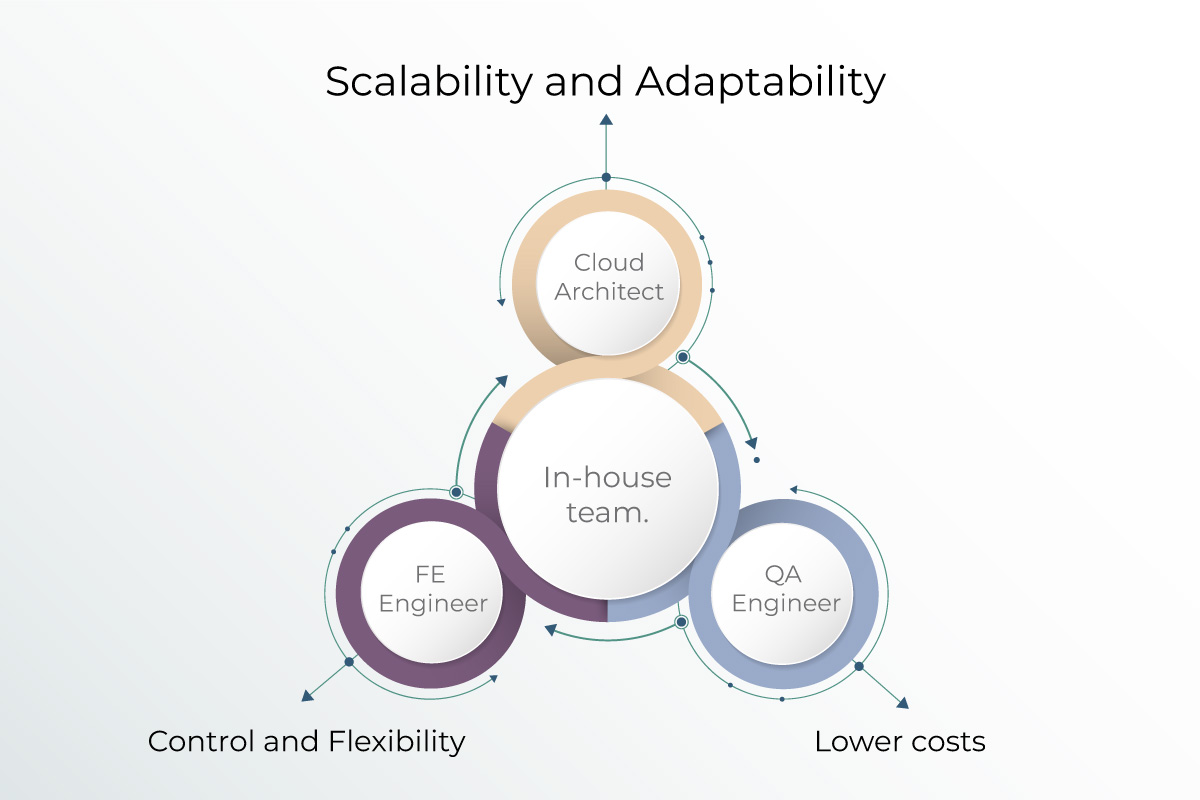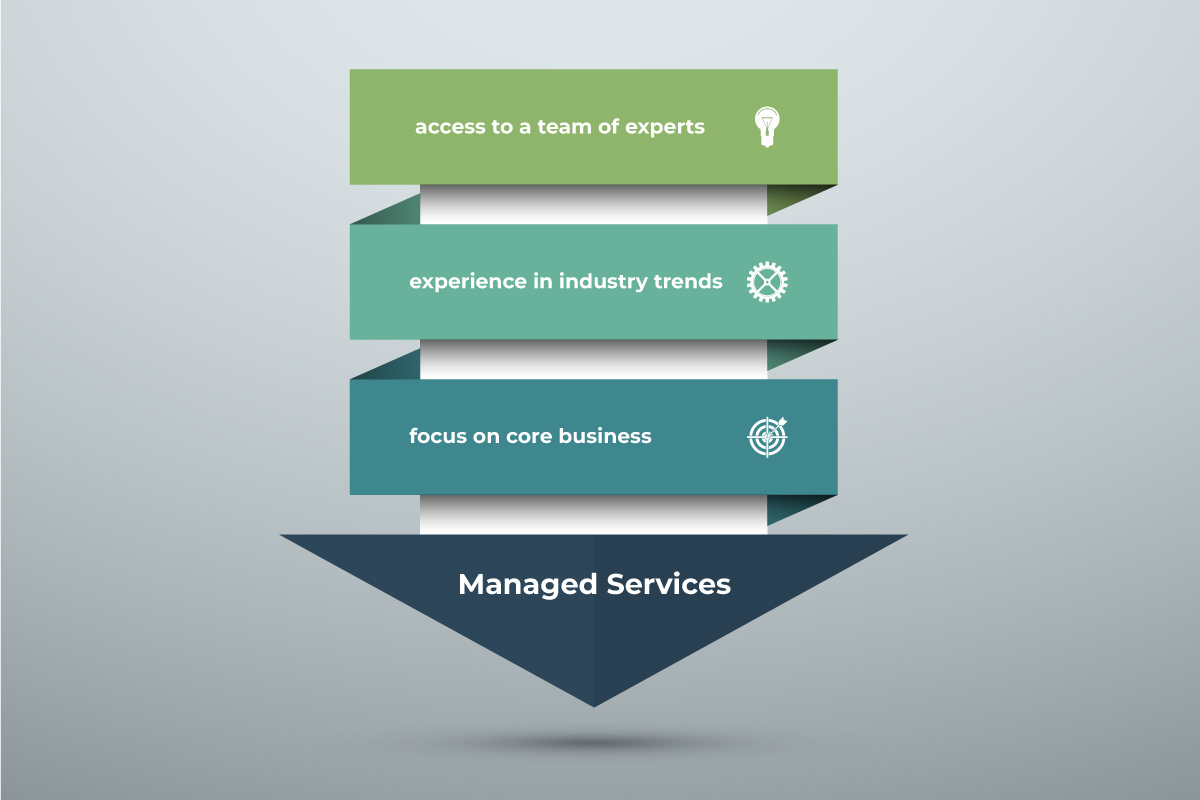
A Comparative Analysis: Staff Augmentation vs. Managed Services.
by Khoa Nguyen
Table of content.
- Staff Augmentation explained.
- Managed Services.
- Key Differences Between Staff Augmentation and Managed Services.
- Choosing Between Staff Augmentation and Managed Services.
In today's fast-paced business landscape, staying ahead of the competition requires a strategic approach to managing your workforce. Two options that often come into play are staff augmentation and managed services. While both aim to fulfill your staffing needs, they differ in several key aspects. In this article, we will delve into the ins and outs of staff augmentation and managed services, exploring their benefits, drawbacks, and key differences. By the end, you will have a clearer understanding of which option might be the best fit for your business.
Understanding Staff Augmentation
Let's start by defining staff augmentation. In simple terms, it refers to hiring external resources on a temporary basis to supplement your existing workforce. These resources, also known as "augments," possess the required skills and expertise to bridge the gap in your team. They work alongside your employees, complementing their efforts and alleviating the strain during peak workloads or specialized projects.
One of the most significant benefits of staff augmentation is the flexibility it offers. Unlike hiring full-time employees, you have the freedom to onboard augments for shorter durations, aligning their term with the specific project requirements. This flexibility allows you to scale your workforce up or down as needed, ensuring optimal resource utilization and cost-effectiveness.
Moreover, staff augmentation provides an opportunity for knowledge transfer and skill enhancement within your existing team. When you bring in external resources with specialized expertise, they can share their knowledge and best practices with your employees. This collaboration not only helps in completing the current project successfully but also enhances the skill set of your team members, enabling them to tackle similar challenges in the future.
However, it's important to acknowledge the potential drawbacks of this approach. Communication and integration may pose challenges when integrating external resources into your existing team. It is crucial to establish effective communication channels and provide clear guidelines to ensure seamless collaboration between your employees and the augments. Regular team meetings and project updates can help foster a sense of unity and shared goals among the team members.
Additionally, staff augmentation often requires diligent oversight and management to effectively integrate the augments and ensure they seamlessly blend with your company culture. It is essential to provide proper orientation and training to the external resources, acquainting them with your company's values, processes, and expectations. By investing time and effort in their integration, you can create a cohesive and productive work environment where everyone feels valued and motivated.
Furthermore, staff augmentation can bring fresh perspectives and innovative ideas to your team. Augments, being external resources, may have worked with different companies and industries, exposing them to diverse practices and approaches. Their unique insights and experiences can contribute to the overall growth and development of your team, fostering a culture of continuous learning and improvement.
In conclusion, staff augmentation offers numerous benefits, including flexibility, knowledge transfer, and fresh perspectives. However, it requires careful management and integration to ensure effective collaboration and alignment with your company's goals and values. By leveraging the strengths of both your existing team and the external resources, you can enhance productivity, meet project demands, and drive overall success.

Exploring Managed Services
Now, let's shift our focus to managed services. Unlike staff augmentation, managed services involve outsourcing specific business functions or processes to an external service provider. These providers, experts in their respective fields, take full responsibility for delivering the required services, relieving you of the burden of managing these functions internally.
Managed services offer a wide range of advantages that can greatly benefit your organization. One of the most significant advantages is the ability to tap into specialized expertise without investing in additional training or hiring. By outsourcing to professionals, you can benefit from their industry knowledge, best practices, and advanced technologies. This not only drives efficiency but also enables you to focus on core business activities, fostering growth and innovation.
When you engage a managed services provider, you gain access to a team of experts who are dedicated to delivering high-quality services. These professionals have extensive experience in their respective fields and stay up-to-date with the latest industry trends and advancements. By leveraging their expertise, you can ensure that your business functions are handled by skilled professionals who understand the intricacies of the tasks at hand.
Furthermore, managed services providers often have access to cutting-edge technologies and tools that may be too expensive or complex for your organization to acquire and maintain on your own. By partnering with a provider, you can leverage their technology infrastructure and benefit from the latest advancements without the need for significant upfront investments.
In addition to the expertise and technology advantages, managed services also offer scalability and flexibility. As your business needs evolve, you can easily adjust the level of services provided by the external provider. Whether you need to scale up during peak periods or scale down during slower times, a managed services model allows for seamless adjustments without the need for significant disruptions or additional costs.
While the benefits of managed services are undeniable, it's crucial to be aware of the possible limitations. For instance, entrusting critical business functions to an external provider requires a high level of trust and transparency. It's important to thoroughly vet potential providers, ensuring they have a proven track record and robust security measures in place to protect your sensitive data and information.
Additionally, you may have less control over the execution and decision-making processes when relying on a managed services provider. This could impact your ability to customize solutions to meet your specific requirements. It's essential to establish clear communication channels and set expectations from the outset to ensure that your needs are met effectively.
In conclusion, managed services offer a compelling solution for organizations looking to streamline their operations, leverage specialized expertise, and drive innovation. By partnering with a trusted provider, you can offload non-core functions, focus on strategic initiatives, and position your business for long-term success.
Key Differences Between Staff Augmentation and Managed Services
When it comes to choosing between staff augmentation and managed services, it's important to consider the various factors that set them apart. While both options have their advantages and disadvantages, understanding the key differences can help you make an informed decision for your business.
Cost Implications
From a cost perspective, staff augmentation typically offers more control over expenses. You have greater flexibility in determining the duration and scope of external resources, allowing you to align costs with the project's budget. This means that if you have a project with a limited budget, staff augmentation can be a cost-effective solution. On the other hand, managed services usually involve long-term contracts with fixed fees, reducing the variability in costs while potentially limiting your ability to make adjustments based on fluctuating needs. This can be beneficial for businesses that prefer a predictable and stable cost structure.
However, it's worth noting that the cost implications of staff augmentation go beyond just the financial aspect. By bringing in external resources, you may also need to consider the time and effort required for onboarding and training. While this can be an additional cost, it can also provide an opportunity for knowledge transfer and skill development within your team.

Control and Flexibility
Staff augmentation provides a higher degree of control and flexibility. As the augment works alongside your team, you maintain direct oversight, ensuring seamless integration and alignment with your objectives. This allows you to have a hands-on approach and make real-time adjustments as needed. With managed services, on the other hand, you relinquish some control, relying on the expertise and judgment of the service provider. While this frees up your internal resources, it requires a thorough assessment of the provider's capabilities and a strong foundation of trust. It's important to establish clear communication channels and expectations to ensure a successful partnership.
Moreover, the level of control and flexibility offered by staff augmentation can also contribute to fostering a collaborative and innovative work environment. By having external resources working closely with your team, you can leverage their expertise and fresh perspectives to drive creativity and problem-solving.
Scalability and Adaptability
When it comes to scalability and adaptability, staff augmentation shines. The ability to quickly add or reduce resources based on workload fluctuations or changing project requirements gives you a significant advantage. This means that if you have a project that requires a flexible workforce, staff augmentation can provide the agility you need. On the other hand, managed services may not offer the same level of agility. As the service provider may have fixed resource allocations, adjustments in response to evolving needs could be more time-consuming or difficult to implement. This is something to consider if your business operates in a dynamic and rapidly changing environment.
Additionally, the scalability and adaptability of staff augmentation can also contribute to better resource utilization. By having the ability to scale up or down as needed, you can optimize resource allocation and ensure that you have the right talent at the right time.
In conclusion, both staff augmentation and managed services have their own strengths and considerations. It's important to carefully evaluate your business needs, project requirements, and long-term goals to determine which option aligns best with your objectives. Whether you choose staff augmentation or managed services, the key is to establish clear communication, set expectations, and foster a collaborative partnership to maximize the benefits of external resources.
Choosing Between Staff Augmentation and Managed Services
Factors to Consider
When faced with the decision between staff augmentation and managed services, it's crucial to evaluate several key factors. Consider the duration and complexity of the project at hand, as well as the availability of internal resources with the necessary expertise. Assess your ability to actively manage and integrate external resources versus entrusting a third party with the responsibility of delivering specific services.
Assessing Your Business Needs
Understanding your business needs is paramount in making an informed decision. Determine whether your requirements will remain consistent or fluctuate frequently. Evaluate the level of control and flexibility you require and consider the impact on your internal teams and resources. Balancing these aspects helps ensure that the chosen approach aligns with your business goals and objectives.
Evaluating Your Resources
Lastly, analyze your existing resources and capabilities. Assess the skills and expertise available internally, and identify any potential skill gaps that need to be addressed. Consider the costs associated with training, onboarding, and retaining additional full-time employees, as well as the options for outsourcing specific functions to specialized service providers.
By thoroughly assessing these factors and understanding the nuances of staff augmentation and managed services, you can confidently choose the option that best suits your business needs. Whether you opt for staff augmentation to complement your internal team or leverage managed services to enhance efficiency, strategic staffing decisions will undoubtedly propel your business forward in today's dynamic marketplace.
Khoa Nguyen, a tech leader with a passion for modern management, brings his expertise in computer science (MSc) and his experience as a lead engineer to the table. He's not just about writing code; he's also driven by optimizing workflows and building high-performing teams through innovative management techniques and agile methodologies.
Think of Khoa as a translator, fluent in both the language of technology and the art of effective leadership. He's your guide to unlocking the full potential of your tech teams through practices that boost efficiency, foster collaboration, and drive results.

Tech lead